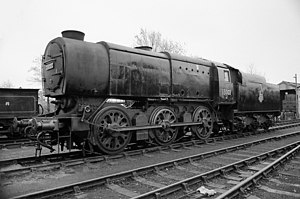SR class Q1
| SR class Q1 BR class Q1 |
|
|---|---|
| Numbering: | SR: C1-C40 BR: 33001-33040 |
| Number: | 40 |
| Manufacturer: |
Brighton Works : 20 Ashford Works : 20 |
| Year of construction (s): | 1942 |
| Retirement: | 1963-1966 |
| Type : | C h2 |
| Gauge : | 1435 mm ( standard gauge ) |
| Length over buffers: | 16.7 m |
| Service mass: | 80.8 t |
| Starting tractive effort: | 140 kN |
| Driving wheel diameter: | 1550 mm |
| Number of cylinders: | 2 |
| Cylinder diameter: | 483 mm (19``) |
| Piston stroke: | 660 mm (26``) |
| Boiler overpressure: | 16 bar |
| Water supply: | 14 m³ |
| Fuel supply: | 4.5 tons of coal |
The Q1-class of the Southern Railway , sometimes as Bulleid Austerity called, was one of Oliver Bulleid designed series of 40 kriegslokomotive that during the Second World War were built and for use on freight trains were determined. The locomotives with a tender with their unusual appearance were the most powerful three-coupler locomotives in Great Britain . They carried the numbers C1 to C40 on the Southern Railway.
history
The Second World War led to a sharp increase in freight traffic in Great Britain, for which the Southern Railway, which was more geared towards suburban traffic from London , had no suitable locomotives. The most obvious solution would have been a replica of the Q-Class , which the head machine engineer Oliver Bulleid did not like because he considered it to be technically outdated and insufficiently efficient. It was decided to build a new three-coupler , which should be made with the least possible effort because of the war. This should not only save scarce material, but also reduce the weight of the locomotive.
The 40 locomotives were built at the railroad's own works in Brighton and Ashford . They were not only used in front of freight trains, but also pulled passenger trains, where they were at least as good as the light Pacific locomotives . The Q1 had above-average running characteristics when driving with the tender ahead, but the view of the staff was obstructed. The locomotive brake was designed to be relatively weak, which was particularly disadvantageous for freight trains with unbraked cars. In rainy weather, the locomotive was unpopular with the staff because the water that was splashing up from the engine and the wheels due to the lack of running plates obstructed the view. Due to its light construction, the locomotive tended to skid . The Q1 class was nevertheless a successful design, which is why the locomotives were in service well beyond the war and into the 1960s.
After the war, thought was given to a replica of 25, with the material already ordered and delivered. But it did not happen because the transport department wanted tank locomotives that were better suited for reversing. Bulleid then proposed the Leader class - an innovative, compact tank locomotive with two motor bogies with a multi-cylinder engine. However, the only built prototype in this class was unsuccessful.
technology
Oliver Bulleid's design was a powerful, reasonably reliable locomotive with an internal engine and the largest grate of all British three-couplers. It was 13 t lighter than comparable locomotives and could therefore be used on most of the Southern Railway routes.
The need to reduce weight resulted in compact controversial design. All parts that are not absolutely necessary, such as running plates or splash guards above the drive wheels , have been left out. A new solution was sought for the boiler cladding that could do without asbestos for thermal insulation because this material was scarce due to the war. Instead, a material called Idaglass was used, an early form of fiberglass insulation. It could not be mechanically loaded, which is why a second outer cladding was necessary for the boiler. The outer skin of the locomotive was kept smooth so that it could be cleaned with a car wash.
The locomotive's idiosyncratic appearance earned the locomotive many names: biscuit tins or biscuit barrels ("biscuit jars"), Charlies , clockworks ("clockworks"), coffee pots (" coffee pots "), Frankensteins , Ugly Ducklings (" ugly ducklings ") or telescopic breadloaves on wheels ("pull-out loaves of bread on wheels").
Preserved locomotives
All Q1-class locomotives were scrapped except for the first, which was number C1 on the Southern Railway. It is preserved in the National Railway Museum (York) in York. Between 1977 and 2004 she was stationed at the Bluebell Railway in Sussex . She was regularly in use there until September 1983.
Movie
- In the British animated series Thomas, the Little Locomotive , the character Neville is based on a Q1 class locomotive.
Web links
- Bulleid Q1 class 0-6-0. Southern Railway E-Group, accessed October 13, 2018 .
Individual evidence
- ↑ a b c Q1 0-6-0 SR Bullied Austerity 33001 - 33040 . In: Preserved British Steam Locomotives . June 22, 2017 ( preservedbritishsteamlocomotives.com [accessed October 12, 2018]).
- ↑ a b Chris Eden-Green: Bulleid Q1 No C1. YouTube, April 16, 2015, accessed October 14, 2018 .
- ^ Southern Railway E-Group, first page
- ^ Southern Railway E-Group, first page
- ↑ Bulleid Q1 Class. Victory Works, accessed October 12, 2018 .
- ^ Southern Railway 0-6-0 Q1 class steam locomotive, No 33001, 1942. Science Museum Collection UK, accessed October 13, 2018 (English).
- ↑ Neville Character Profile & Bio . In: Thomas & Friends - Official Website . Retrieved August 26, 2017.

